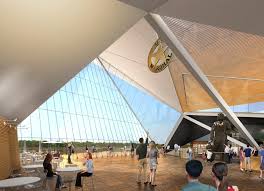Planned U.S. Marshals Museum relevant to nation, Fort Smith
by July 11, 2016 2:41 pm 294 views
Editor’s note: This is the first of two guest commentaries from Jim Dunn, president of the U.S. Marshals Museum Foundation.
–––––––––––––––
Civic literacy, history, and knowledge of the institutions that bind this country together are endangered. “Heritage” or “cultural” tourism is declining. Some believe the U.S. Marshals Museum will not be built for these reasons. Yet those are the very reasons why this museum must and will be built.
Our republic depends upon knowledge of and appreciation for its Constitution and the enforcement of the Rule of Law. Public schools no longer prioritize civics and history education as was the case a generation or two ago. The storied history of the U.S. Marshals Service is the perfect context in which to teach these great American values.
The museum is committed to this educational mission through its National Learning Center, the Samuel M. Sicard Hall of Honor, and its galleries.
The museum’s centerpiece of combatting civic illiteracy is its Winthrop Paul Rockefeller Distinguished Lecture Series, whose first lecturer was U.S. Supreme Court Associate Justice Antonin Scalia, who died earlier this year. An article on the first anniversary of Justice Scalia’s lecture in Fort Smith, published shortly after his death, featured three area students and the impact of the lecture on the students. Lectures by high-ranking leaders in the two remaining branches of government – executive and legislative – are planned.
The museum has sponsored another 14 lectures in the community, all related to civics and law enforcement, attracting hundreds. The museum has produced three “tool kits” relating to the nation’s history and has distributed them to 431 teachers in 18 states, and one sent to France, reaching up to 10,755 students each year they are used. The latest tool kit, just completed – “U.S. Marshals & the Civil Rights Movement,” in memory of Deputy U.S. Marshal Josie Wells, killed in the line of duty last year – can soon be accessed on the museum’s website, and is expected to be more widely distributed than the others.
In addition, the museum and the American Democracy Project at the University of Arkansas at Fort Smith partnered to take a reading about the U.S. Constitution to all fourth- and fifth-grade classes in the Fort Smith Public Schools for Constitution Day 2015. Students also received a pocket copy of the Constitution. The program is being extended to second- and third-grade classes in 2016. The two institutions also hosted the Unsung Heroes Banquet at UAFS in January 2016 that featured retired Deputy U.S. Marshal Richard Bowden, who escorted James Meredith while he attended the University of Mississippi. Opportunities for future collaboration are virtually unlimited.

Just think what the museum will do once it is completed, staffed, and operating.
The museum is uniquely poised to utilize its exhibits and artifacts to tell the story of the Marshals. Evidence of this is the recent hiring of Patrick Weeks as the new president and CEO. Weeks brings more than 20 years of creating experiences for visitors, embedding this message into the visitor’s mind. Examples can be found at the Abraham Lincoln Presidential Library and Museum in Springfield, Ill., and the Arizona Science Center in Phoenix. The stories of the Marshals, powerfully told, illustrate the importance of the Rule of Law and its enforcement to the nation. As a bonus, Weeks also brings years of operational expertise with him to help ensure the financial health of the project.
The museum also will be impactful locally in many different ways.
The museum has reached out to the Five Civilized Tribes of Oklahoma, who share a common history with the Marshals. The potential for cooperative cultural events at the museum, such as cultural t fairs, is enormous. Shared history, complete with conflict and cooperation, presents educational opportunities on issues still germane today. The Tribes are represented on the museum’s Board of Directors. The Tribes have committed to build a monument to tribal law enforcement on the museum’s campus. Museum and community leaders have taken “field trips” to three of the five nations to see first-hand tribal economic and cultural development.
The museum has established relationships with Crystal Bridges Museum of American Art in Bentonville and the William J. Clinton Presidential Library and Museum in Little Rock. It has reached out to the Gilcrease Museum in Tulsa, Okla., the Oklahoma History Center in Oklahoma City, and others. Fort Smith is near the geographical center of an area of the country bursting with development of cultural and historic attractions. The museum has an unparalleled opportunity to tap in to the growth and development, in turn, helping to grow downtown Fort Smith and the riverfront.
The museum is an investment in the quality and vitality of Fort Smith’s civic life and can be a centerpiece of civic identity and pride. Its success and economic impact depend upon the community vision and leadership and commitment to its downtown and riverfront. That vision and commitment are manifested by numerous quality-of-life projects now underway – the Greg Smith River Trail, The Unexpected downtown mural project, the restoration of the Temple Theatre, local filmmaking by Mad Possum Productions, and much more. There is little doubt about Fort Smith’s vision and commitment to projects of this sort.
The community, its donors, the two Boards of Directors, the U.S. Marshals Service, retired marshals, the tourism and travel industry, the staff, and others want the museum built as soon as possible. The next installment in this series will look at the financial challenges and opportunities that lie immediately ahead.
